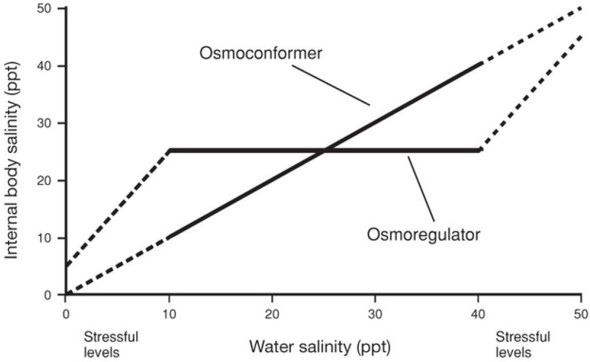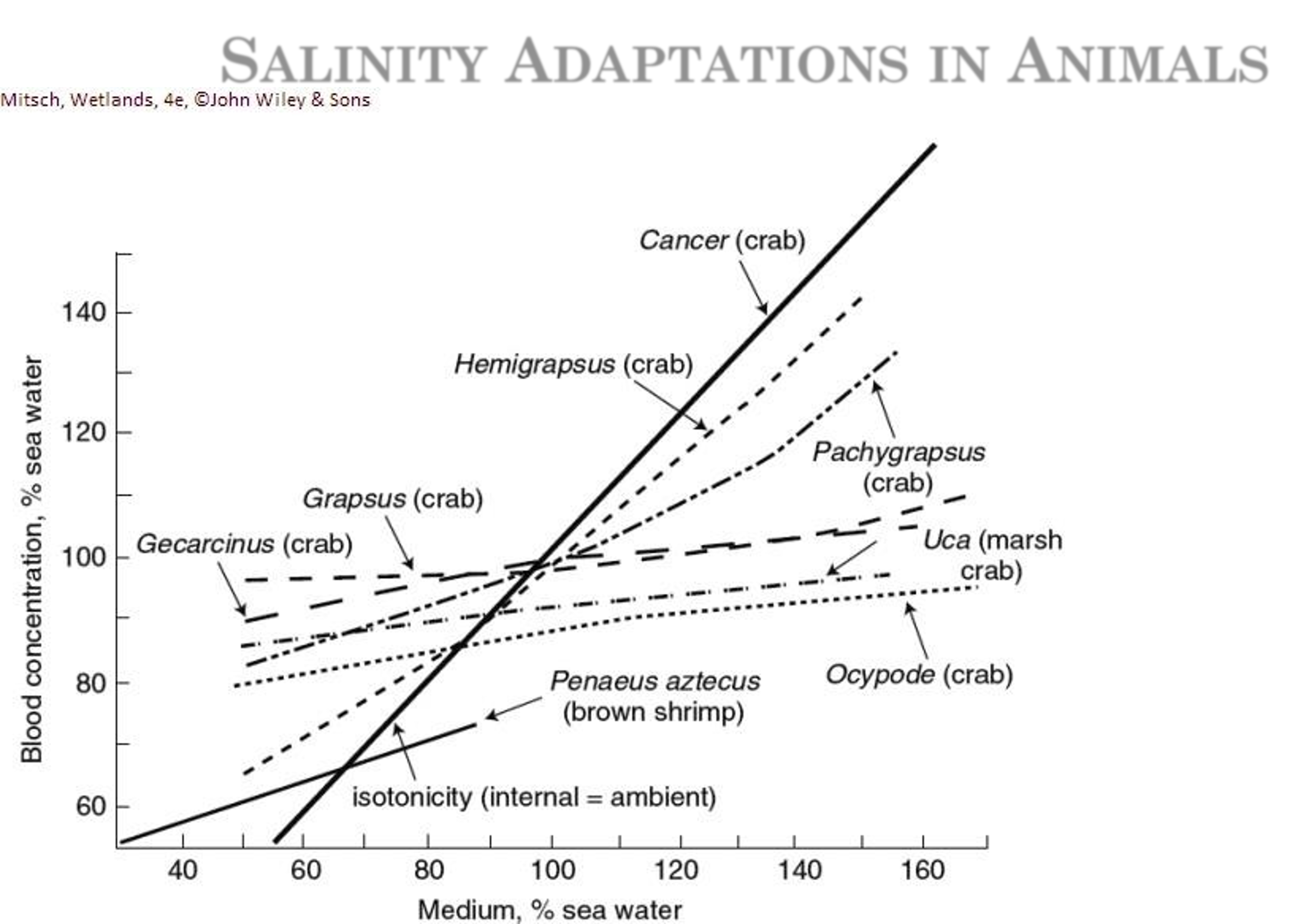3 - Abiotic Constraints & Biological Adaptations
1/20
There's no tags or description
Looks like no tags are added yet.
Name | Mastery | Learn | Test | Matching | Spaced |
|---|
No study sessions yet.
21 Terms
Root oxygen deficiency – what is the term for “oxygen deficiency,” why does this happen, and what does it result in?
Does not mean lack of oxygen, but the oxygen is not enough. Hypoxia = oxygen deficiency -> happens because the O2 diffusion in water is 1000 times slower. This will result in cell acidosis -> the pH of the cell cytoplasm decreases, which impairs cell function. Because we don’t have oxygen, the cell will continue to gather ATP, leading it to have a lot of lactic acid and therefore cause for a more acidic pH.
Soil phytotoxin accumulation – which two metals accumulate to toxic levels and why? Which toxic gas accumulation results from flooding?
Mn and Fe -> when reduced, they are soluble and accumulate to toxic levels. Hydrogen sulfide is produced when SO4 is reduced to a toxic gas. Phyto = plant. When these are within high concentrations, they will be toxic for the plants. High quantity of sulfur and low oxygen.
Postanoxic injury – what does anoxia refer to? How does “postanoxic injury” occur?
Anoxia = lack of oxygen. Re-exposure to oxygen after anoxia can produce relative oxygen species such as a superoxide and peroxide that are harmful. Think of how when your hands get cold you should not put them in hot water. In need of protons so they are desperate for chem rxns. This hurts the plants.
Plant adaptations to flooding are grouped into two main categories. How do these differ in their action?
Anatomical – Morphological
Metabolic - Physiological adaptations
Allow plants to avoid oxygen stress via providing oxygen from the atmosphere
Biochemical processes that are aimed at countering the negative impacts that result from oxygen deficiency
Below are some anatomical-morphological adaptations, what does each one entail?
1.Aerenchyma tissue
2.Stem hypertrophy & fluted trunks
3.Roots: adventitious roots, prop roots, pneumatophores and cypress “knees”
4.Lenticels
5.Shoots: Rapid vertical growth/growth dormancy
1.Cells die and leave empty space. Air spaces in roots in stems deliver oxygen from aerial portions to the roots
2.Stem hypertrophy -> Response to stress that involves swelling at the base. Good indicator of wetland conditions. In trees, this is called a buttress. There is a lack of oxygen at some point and it needs to send oxygen somehow. Air can be pushed into empty space at the base and then into the roots. Fluted trunk -> Classic flare is a genetic feature whilst the buttress is environmental
3.Adventitious roots -> Roots that develop on the stem just above the anaerobic zone. They function normally in the aerobic zone just above the water line. Prop roots -> Aerial roots that extend from the trunk of the tree down into the soil. Pneumatophores/”knees” -> protrude out of the soil and are exposed to the air to air with oxygen delivery. These can be covered in lenticels.
4.Lenticels -> small slits or pores on the stem or trunk that allow for gas exchange to living interior cells
5.Plants that avoid or deal with lack of oxygen by growing really fast.
what do the following physiological adaptations involve?
anaerobic respiration
protection against postanoxic injury
pressurized gas flow
reduce toxicity in the oxidized rhizosphere
Cellular respiration
Glycolysis -> only gives a small amount of ATP
Citric acid cycle
Electron transport chain
Alcoholic fermentation is accelerated -> Pasteur effect to make up for low ATP
This isn’t really a good thing but that’s okay
Wasteful
Absence of oxygen
How do plants acheive this? Accumulate and sequester toxic substances -> pile them up away from the important cells (vacuoles)
Activate enzymes that remove the toxic substances by converting nontoxic forms to forms that can diffused out of the plant
Changes in temperature or humidity cause a slight pressure that forces air down to the roots, increasing rate of air flow to the roots.
Not very common -> this is more for herbaceous plants
How the oxygen from the previous step is used
Reduced ions that are mobile are re-oxidized and precipitated in the rhizosphere
When the oxygen is pushed down into the roots and then diffused outwards it will re-oxidize the Fe and Mn back into non toxic levels (Fe2+ -> Fe2+)
Terrestrial animals have no adaptations, they simply respond (behavioral) to flooding by
moving to higher ground
retreating in air-filled burrows
How do aquatic animals deal with flooding constraints?
1.Carrying air under their wings, e.g., beetles
2.Use siphon tubes to breathe surface air, e.g., mosquito larvae
3.Use siphons to access oxygen in aerenchyma
4.Congregate around plant roots to use the oxidized rhizosphere
5.Modified respiratory pigment (hemoglobin) with a higher affinity (attraction) for O2.
Switch to anaerobic respiration or become inactive
Impacts of DRYING on Wetland Plants
Drying (drought) creates a deficiency in soil moisture
Some plants with adaptions to flooding are not tolerant to drought because they are more likely to lose water.
Drought results in re-oxidation and possible release of toxic metals
Drought also leads to fires, adding another level of stress
Plant adaptations to drought involve either avoiding or tolerating the drought.
Plant Adaptations to drying: avoidance
Increased resistance to water loss -> stomatal or cuticular thickening
Changing leaf area, anatomy, orientation -> leaf curling
Improved water uptake, storage and use efficiencies -> just be more efficient with water use
Plant Adaptations to drying: tolerance
Dormancy during dry periods
Reduced body size and prostrate growth -> low/horizontal
Altering chemical comp and physical properties of cells
Long seed visibility
After hydrology, salinity is what differentiates freshwater and tidal wetlands
Types of wetlands in which salinity variation is an important ecological factor are …
Brackish marsh (NaCl -> tidal)
Salt marsh (NaCl -> tidal)
Non-tidal inland wetlands that are freshwater but due to high levels of evaporation, the salts come up and therefore accumulate in the soil. Arid or semi-arid regions (due to evaporation rate). (CaCO3 -> being picked up from rocks)

Most plants (99%) are glycophytes – salt intolerance, growth is inhibited by increase in salinity
Halophytes – can tolerate elevated salinities
Facultative halophytes – don’t require salt for growth but can tolerate it
Obligate halophytes – require some salt to grow & survive
Which types do the graphs represent?
Figure: as you increase salinity what happens to plant growth
A.Glycophytes -> all die
B.Facultative halophytes -> goes down but can survive
C.Obligate halophytes -> growth goes up with salinity but then goes down once it reaches a threshold
D.Obligate halophytes -> growth goes up with salinity but then goes down once it reaches a threshold
Three main impacts result when salinities rise beyond tolerance limits. What does each of these entail?
osmotic effect
ion toxicity
impaired nutrient uptake
How do obligates survive past their preferred salinity threshold?
Because the salinity of the water is higher, the plant roots cannot take in any salts. This effects root uptake. This just has to do with osmosis as the salinity of the soil is much more and therefore the water will move towards that due to the gradient.
High concentrations of Na and Cl ions will impair the cell membrane structure and disrupt the protein synthesis and enzyme activity. Due to the high amount of salt in the water, it will interfere with the enzyme activity.
Ions in saline water inhibit the uptake of essential nutrients. Na+ will inhibit the uptake of NH4+.
PLANT ADAPTATIONS - AVOIDANCE
Salinity avoidance uses mechanisms that avoid high internal salt levels in the plant. How does each mechanism work?
1.Exclusion – not common
2.Excretion – more common
3.Dilution
They can just avoid it! How can we reduce the accumulation of salt within the plant
1.Excluding the salt. The plant has to find a way to avoid taking up the salts at the root surface. They do this through altered Na/K ratios in the plant tissue.
2.Get rid of it! They accumulate salt in salt glands and push them out! Cool. E.g. cordgrass.
3.Through succulence, salt that is taken up by the plant is diluted.
PLANT ADAPTATIONS - TOLERANCE
Tolerance allows plants to better endure the effects of elevated salinities. Most plants use both avoidance and tolerance simultaneously
Compartmentalization – how does this strategy work?
Osmotic adjustment – how does this strategy work?
Lets tolerate. Most plants have to utilize multiple adaptations btw.
1.Sequester toxic ions as Na and Cl in the cell vacuole.
2.Synthesize non toxic organic compounds to counter the osmotic differences between the cell cytoplasm and the vacuole. The high concentration in the vacuole will cause the water to leave -> therefore causing dehydration.

Salinity Adaptations in Animals
How do these strats work:
Osmoconformers
osmoregulators
Specific to aquatic animals in tidal wetlands (marine)
- Dark part of the line is the ideal salinity
They change with the tide. Internal environment follows the osmotic concentration of the external environment -> their internal salt levels mimic the external so they are easily permeable to water and salt. Most simple animals do this.
Does not matter what the salinity in the water is. They are internally regulating the internal salinity therefore staying the same. These control their internal osmotic concentration to remain the same even when the external salinity changes. Some will eventually conform, but if it is too much they will die.

Which ones are osmoconformers?
Which ones are osmoregulators?
Osmoconformers -> Hemigraspsus, Cancr, Pachygraspsus
Osmoregulators -> Grapsus, Gecarcinus, Unca, Ocypode
Acidity (pH < 7) is mostly an issue in inland wetlands with little to no inflows and wetlands fed mainly by rainwater
Acidity impacts nutrient availability, specifically…
Associated with wetlands that have major drying periods
Micronutrients -> nutrients that plants need in a very low amount. Once you increase their concentrations, they become toxic to the plant. Zn, Cu, Co, Fe, Mn are more available in acidic conditions
Macronutrients -> nutrients that plants need in a high amount. Under acidic conditions, these become attached to other substances, forming a complex, which cannot be taken in by the plant. Mb, K, Ca, Mg, S are physically present but not biologically available.
P -> macronutrient. This is less available in acidic conditions due to being sorbed to Al and Fe – it is sorbed to Mg and Ca in high pH/basic conditions
Acidity Effects on animals
Fishes do not tolerate low pH due to high Al toxicity – are absent in wetlands with low pH
Macroinvertebrates – generally low pH excludes animals with shells (e.g., gastropods, mollusks, ostracods)
Birds are affected indirectly due to their diet preferences – if fishes or macroinvertebrates are absent, the birds that eat them will also be absent
It’s suggested that presence of macroinvertebrates in acidic waters is just a benefit from lack of fish